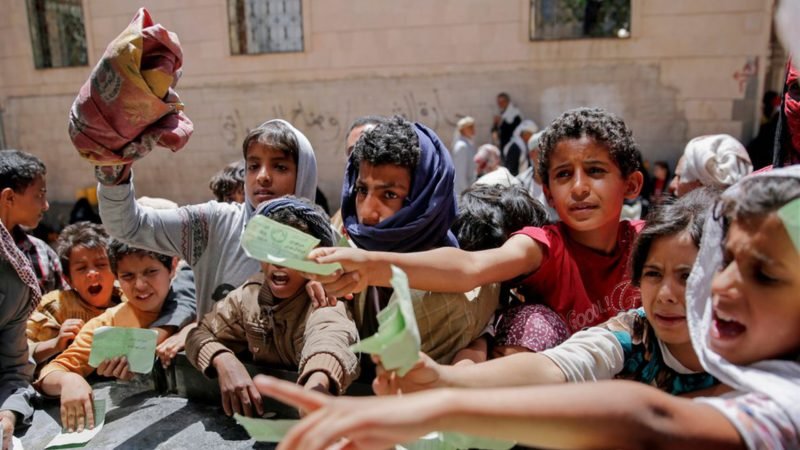Yemen’s Proxy Wars: A Humanitarian Emergency

Yemen, one of the poorest countries in the region, has been torn apart by civil war. The repercussions have been significant as the conflict evolved into a proxy war between Saudi Arabia and Iran. The Saudi-led coalition of mostly Sunni Arab states aims to restore the internationally recognized government of Yemen, while on the other hand, Iran has been repeatedly accused of supporting the rebel movement, Houthis, a minority group of Zayadi Shiites.
The ongoing conflict can be traced back to the Arab Spring in 2011 which had resulted in the removal of the authoritarian leader and president, Ali Abdullah Saleh. His deputy, Abdrabbuh Mansour Hadi came in power instead. However, the political transition was rife with problems and Hadi had to flee to Saudi Arabia in 2015 after the takeover of the Yemeni capital of Sana’a by the Houthis.

Since 2015, over 40,000 conflict events have been reported and over 100,000 fatalities have been reported by ACLED (Armed Conflict & Event Data Project) as of 2019. United Nations has referred to the crisis as the world’s largest humanitarian catastrophe. This conflict has witnessed an obstruction of desperately needed humanitarian aid, innumerable airstrikes killing large scores of civilians, and thousands of fatalities from preventable causes such as malnutrition and disease.
“An estimated 80 percent of the population – 24 million people – require some form of humanitarian or protection assistance, including 14.3 million who are in acute need. The severity of needs is deepening, with the number of people in acute need a staggering 27 per cent higher than last year. Two-thirds of all districts in the country are already pre-famine, and one-third face a convergence of multiple acute vulnerabilities,” reported United Nations Office for the Coordination of Humanitarian Affairs (OCHA).
The crisis has had a disproportionate effect on children in Yemen as about 400,000 children under age 5 suffer from acute malnutrition and they are at high risk of recruitment into armed groups and child marriages. In addition, over two million children have been withheld from schools

Both the Yemeni government and Houthi militias have been documented by human rights groups to have arbitrarily detain, torture and forcibly disappear countless people who they have suspected of being security threats. According to the Human Rights Watch, guards in a detention centre for migrants and asylum seekers in Aden have been complicit in torturing, raping and executing the detainees, including children.
All parties have been alleged of grossly violating human rights and international law. War crimes have been rampant as Houthis captured hostages and Saudi-led coalition have bombed soft targets such as schools and clinics.
According to a recent report from UNDP, “Since 2014, war has driven poverty in Yemen from 47 percent of the population to a projected 75 percent by the end of 2019. If the fighting continues through 2022, Yemen will rank as the poorest country in the world, with 79 percent of the population living under the poverty line and 65 percent classified as extremely poor.”
An estimate of 3.3 million people in Yemen have been displaced due to the ongoing war. Most of the refugees have fled to Djibouti, Ethiopia, Oman, Saudi Arabia, Somalia and Sudan. More than a million have been internally displaced and forced to live in makeshift shelters in urban and rural areas. Most of the country’s infrastructure is in ruins as residential areas, schools, roads and bridges are bombed on a regular basis. In addition to the lack of food, Yemen is also facing the possibility of soon running out of water. Only around half of the households have access to safe drinking water and most of the water available is consumed by agricultural needs.
The advent of the COVID-19 pandemic has brought a new wave of problems for the war-torn country. Moreover, it has coincided with time of the year which is associated with outbreaks of cholera.
Lisa Grande, the head of UN’s humanitarian program in Yemen commented, “If there is one country that cannot deal with a coronavirus outbreak, it is Yemen. The health system is fragile and, in many cases, broken. And after five years of war, the immunities of the population are some of the worst in the world.” She further added, “Yemenis are starving. We fear people are going to die of cholera and now we’ve got coronavirus.”
The pandemic has forced humanitarian agencies to only bring in essential staff and the healthcare system in Yemen was already in ruins. It is nearly impossible for necessary measures such as social distancing and isolating to be imposed as most of the population is housed in temporary settlements and camps for displaced people.
International Committee of the Red Cross has predicted rising levels of hunger, malnutrition and chronic illnesses. This poses a significant challenge, especially since many major UN programs are being shut due to lack of funds.
Ms Grande elaborated, “There are 41 major UN programs, and 31 of those programs will either be shut this month of April or reduced. We’re talking food programs, health programs, water and sanitation programs, protection programs, shelter programs. So, we have a crisis created by the war. We have a crisis created by COVID.”

A ray of hope
On 2 June 2020, the virtual High-Level Pledging Event for the Humanitarian Crisis in Yemen brought together representatives of more than 125 Member States, and International Organizations, UN Agencies, NGOs and Civil Society to raise funding to meet the humanitarian needs of people affected by the conflict.
Thirty countries announced pledges for humanitarian action in Yemen, including 14 announcements to support the Yemen Humanitarian Fund. Altogether, donors pledged $1.35 billion.
Interestingly, Saudi Arabia pledges to donate $500 Million in this high-level dialogue, whereas, Iran’s name was missing from the donor’s list.


















